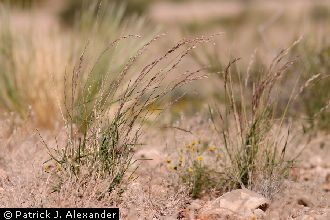Slim Tridens
Scientific Name: Tridens muticus (Torr.) Nash

| General Information | |
|---|---|
| Usda Symbol | TRMU |
| Group | Monocot |
| Life Cycle | Perennial |
| Growth Habits | Graminoid |
| Native Locations | TRMU |
Plant Guide
Use a soil moisture meter to monitor the soil moisture where Slim Tridens is planted.
Fact Sheet
Uses
Cattle and horses graze slim tridens. Rodents and birds eat the seeds.
Description
Grass Family (Poaceae). Slim tridens is a native, warm-season, perennial bunch grass. The height ranges from 8 to 12 inches. The leaf blade is narrow, and rolled giving a needlelike appearance and sometimes sparsely covered with fine hairs. The leaf sheath is shorter than the internodes and usually covered with short hairs. The ligule is a ring of hairs. The stems are erect, slender, and somewhat swollen at the base. The seedheads are dense panicles, spikelets with 6- to 8-flowered, and pale purplish. The back of the palea is densely covered with hair. Distribution: For current distribution, please consult the Plant Profile page for this species on the PLANTS Web site.
Management
Although this grass makes up 10 to 15 percent of the total production on some sites, it is seldom considered a key management species because associated grasses are more palatable, It is an increaser on cattle ranges, Its abundance indicates fair to poor range condition, Use soil moisture sensors to measure the soil moisture of Slim Tridens., From Hitchcock (1950) @ plants,usda,gov
Establishment
It makes most of its growth in the late spring and the seedheads generally appear 4 to 5 weeks later. The bunches are seldom more than 3 to 4 inches in diameter. It is adapted to well-drained, rocky calcareous soils. Cultivars, Improved and Selected Materials (and area of origin) Please contact your local NRCS Field Office.


